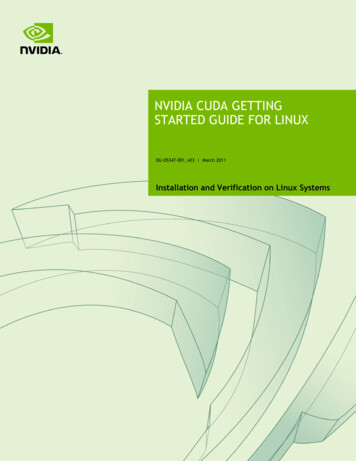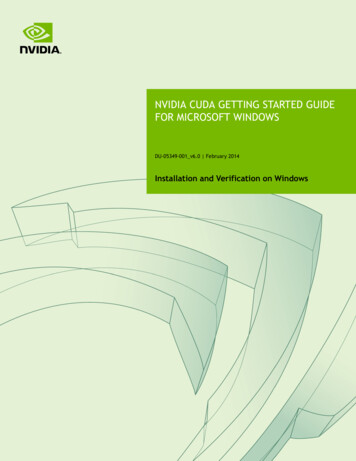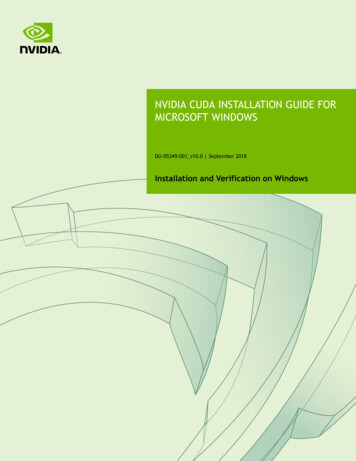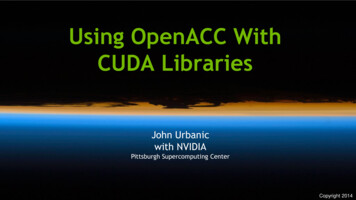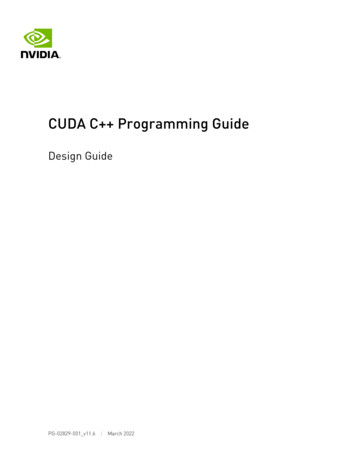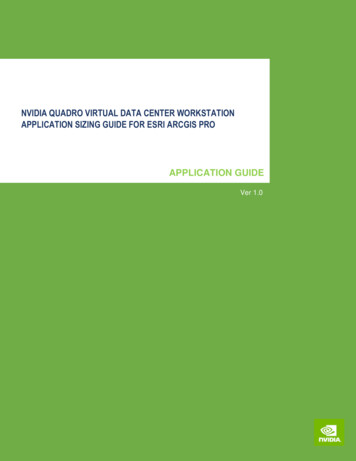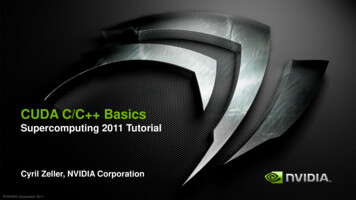
Transcription
CUDA C/C BasicsSupercomputing 2011 TutorialCyril Zeller, NVIDIA Corporation NVIDIA Corporation 2011
What is CUDA? CUDA Architecture Expose GPU computing for general purpose Retain performance CUDA C/C Based on industry-standard C/C Small set of extensions to enable heterogeneous programming Straightforward APIs to manage devices, memory etc. This session introduces CUDA C/C NVIDIA Corporation 2011
Introduction to CUDA C/C What will you learn in this session?Start from “Hello World!” Write and execute C code on the GPU Manage GPU memory Manage communication and synchronization NVIDIA Corporation 2011
Prerequisites You (probably) need experience with C or C You don’t need GPU experience You don’t need parallel programming experience You don’t need graphics experience NVIDIA Corporation 2011
Heterogeneous ComputingBlocksThreadsCONCEPTSIndexingShared memorysyncthreads()Asynchronous operationHandling errorsManaging devices NVIDIA Corporation 2011
CONCEPTSHeterogeneous ComputingBlocksThreadsIndexingShared memorysyncthreads()Asynchronous operationHELLO WORLD! NVIDIA Corporation 2011Handling errorsManaging devices
Heterogeneous Computing Terminology: HostThe CPU and its memory (host memory) Device The GPU and its memory (device memory)Host NVIDIA Corporation 2011Device
Heterogeneous Computing#include iostream #include algorithm using namespace std;#define N1024#define RADIUS 3#define BLOCK SIZE 16global void stencil 1d(int *in, int *out) {shared int temp[BLOCK SIZE 2 * RADIUS];int gindex threadIdx.x blockIdx.x * blockDim.x;int lindex threadIdx.x RADIUS;// Read input elements into shared memorytemp[lindex] in[gindex];if (threadIdx.x RADIUS) {temp[lindex - RADIUS] in[gindex - RADIUS];temp[lindex BLOCK SIZE] in[gindex BLOCK SIZE];}device code// Synchronize (ensure all the data is available)syncthreads();parallel function// Apply the stencilint result 0;for (int offset -RADIUS ; offset RADIUS ; offset )result temp[lindex offset];// Store the resultout[gindex] result;}void fill ints(int *x, int n) {fill n(x, n, 1);}serial functionint main(void) {int *in, *out;// host copies of a, b, cint *d in, *d out;// device copies of a, b, cint size (N 2*RADIUS) * sizeof(int);// Alloc space for host copies and setup valuesin (int *)malloc(size); fill ints(in, N 2*RADIUS);out (int *)malloc(size); fill ints(out, N 2*RADIUS);// Alloc space for device copiescudaMalloc((void **)&d in, size);cudaMalloc((void **)&d out, size);host code// Copy to devicecudaMemcpy(d in, in, size, cudaMemcpyHostToDevice);cudaMemcpy(d out, out, size, cudaMemcpyHostToDevice);// Launch stencil 1d() kernel on GPUstencil 1d N/BLOCK SIZE,BLOCK SIZE (d in RADIUS, d out RADIUS);// Copy result back to hostcudaMemcpy(out, d out, size, cudaMemcpyDeviceToHost);// Cleanupfree(in); free(out);cudaFree(d in); cudaFree(d out);return 0;} NVIDIA Corporation 2011serial codeparallel codeserial code
Simple Processing FlowPCI Bus1. Copy input data from CPU memory to GPUmemory NVIDIA Corporation 2011
Simple Processing FlowPCI Bus1. Copy input data from CPU memory to GPUmemory2. Load GPU code and execute it,caching data on chip for performance NVIDIA Corporation 2011
Simple Processing FlowPCI Bus1. Copy input data from CPU memory to GPUmemory2. Load GPU program and execute,caching data on chip for performance3. Copy results from GPU memory to CPUmemory NVIDIA Corporation 2011
Hello World!int main(void) {printf("Hello World!\n");return 0;}Output: Standard C that runs on the host NVIDIA compiler (nvcc) can be used to compileprograms with no device code NVIDIA Corporation 2011 nvcchello world.cu a.outHello World!
Hello World! with Device Codeglobal void mykernel(void) {}int main(void) {mykernel 1,1 ();printf("Hello World!\n");return 0;} Two new syntactic elements NVIDIA Corporation 2011
Hello World! with Device Codeglobal void mykernel(void) {} CUDA C/C keyword global indicates a function that: Runs on the device Is called from host code nvcc separates source code into host and device components Device functions (e.g. mykernel()) processed by NVIDIA compiler Host functions (e.g. main()) processed by standard host compiler- gcc, cl.exe NVIDIA Corporation 2011
Hello World! with Device Codemykernel 1,1 (); Triple angle brackets mark a call from host code to device codeAlso called a “kernel launch” We’ll return to the parameters (1,1) in a moment That’s all that is required to execute a function on the GPU! NVIDIA Corporation 2011
Hello World! with Device Codeglobal void mykernel(void) {}int main(void) {mykernel 1,1 ();printf("Hello World!\n");return 0;} mykernel() does nothing, somewhatanticlimactic! NVIDIA Corporation 2011Output: nvcc hello.cu a.outHello World!
Parallel Programming in CUDA C/C But wait GPU computing is about massiveparallelism! We need a more interesting example We’ll start by adding two integers and build upto vector additiona NVIDIA Corporation 2011bc
Addition on the Device A simple kernel to add two integersglobal void add(int *a, int *b, int *c) {*c *a *b;} As before global is a CUDA C/C keyword meaning add() will execute on the device add() will be called from the host NVIDIA Corporation 2011
Addition on the Device Note that we use pointers for the variablesglobal void add(int *a, int *b, int *c) {*c *a *b;} add() runs on the device, so a, b and c must point to device memory We need to allocate memory on the GPU NVIDIA Corporation 2011
Memory Management Host and device memory are separate entities Device pointers point to GPU memoryMay be passed to/from host codeMay not be dereferenced in host code Host pointers point to CPU memoryMay be passed to/from device codeMay not be dereferenced in device code Simple CUDA API for handling device memorycudaMalloc(), cudaFree(), cudaMemcpy() Similar to the C equivalents malloc(), free(), memcpy() NVIDIA Corporation 2011
Addition on the Device: add() Returning to our add() kernelglobal void add(int *a, int *b, int *c) {*c *a *b;} Let’s take a look at main() NVIDIA Corporation 2011
Addition on the Device: main()int main(void) {int a, b, c;int *d a, *d b, *d c;int size sizeof(int);// host copies of a, b, c// device copies of a, b, c// Allocate space for device copies of a, b, ccudaMalloc((void **)&d a, size);cudaMalloc((void **)&d b, size);cudaMalloc((void **)&d c, size);// Setup input valuesa 2;b 7; NVIDIA Corporation 2011
Addition on the Device: main()// Copy inputs to devicecudaMemcpy(d a, &a, size, cudaMemcpyHostToDevice);cudaMemcpy(d b, &b, size, cudaMemcpyHostToDevice);// Launch add() kernel on GPUadd 1,1 (d a, d b, d c);// Copy result back to hostcudaMemcpy(&c, d c, size, cudaMemcpyDeviceToHost);// CleanupcudaFree(d a); cudaFree(d b); cudaFree(d c);return 0;} NVIDIA Corporation 2011
CONCEPTSHeterogeneous ComputingBlocksThreadsIndexingShared memorysyncthreads()Asynchronous operationRUNNING IN PARALLEL NVIDIA Corporation 2011Handling errorsManaging devices
Moving to Parallel GPU computing is about massive parallelism So how do we run code in parallel on the device?add 1, 1 ();add N, 1 (); Instead of executing add() once, execute N times in parallel NVIDIA Corporation 2011
Vector Addition on the Device With add() running in parallel we can do vector addition Terminology: each parallel invocation of add() is referred to as a block The set of blocks is referred to as a grid Each invocation can refer to its block index using blockIdx.xglobal void add(int *a, int *b, int *c) {c[blockIdx.x] a[blockIdx.x] b[blockIdx.x];} By using blockIdx.x to index into the array, each block handles adifferent element of the array NVIDIA Corporation 2011
Vector Addition on the Deviceglobal void add(int *a, int *b, int *c) {c[blockIdx.x] a[blockIdx.x] b[blockIdx.x];} On the device, each block can execute in parallel:Block 0c[0] a[0] b[0];Block 2c[2] NVIDIA Corporation 2011 a[2] b[2];Block 1c[1] a[1] b[1];Block 3c[3] a[3] b[3];
Vector Addition on the Device: add() Returning to our parallelized add() kernelglobal void add(int *a, int *b, int *c) {c[blockIdx.x] a[blockIdx.x] b[blockIdx.x];} Let’s take a look at main() NVIDIA Corporation 2011
Vector Addition on the Device: main()#define N 512int main(void) {int *a, *b, *c;int *d a, *d b, *d c;int size N * sizeof(int);// Alloc space for devicecudaMalloc((void **)&d a,cudaMalloc((void **)&d b,cudaMalloc((void **)&d c,// Alloca (intb (intc (int NVIDIA Corporation 2011// host copies of a, b, c// device copies of a, b, ccopies of a, b, csize);size);size);space for host copies of a, b, c and setup input values*)malloc(size); random ints(a, N);*)malloc(size); random ints(b, N);*)malloc(size);
Vector Addition on the Device: main()// Copy inputs to devicecudaMemcpy(d a, a, size, cudaMemcpyHostToDevice);cudaMemcpy(d b, b, size, cudaMemcpyHostToDevice);// Launch add() kernel on GPU with N blocksadd N,1 (d a, d b, d c);// Copy result back to hostcudaMemcpy(c, d c, size, cudaMemcpyDeviceToHost);// Cleanupfree(a); free(b); free(c);cudaFree(d a); cudaFree(d b); cudaFree(d c);return 0;} NVIDIA Corporation 2011
Review (1 of 2) Difference between host and device HostCPU Device GPU Using global to declare a function as device code Executes on the device Called from the host Passing parameters from host code to a device function NVIDIA Corporation 2011
Review (2 of 2) Basic device memory management cudaMalloc()cudaMemcpy()cudaFree() Launching parallel kernels Launch N copies of add() with add N,1 ( ); Use blockIdx.x to access block index NVIDIA Corporation 2011
CONCEPTSHeterogeneous ComputingBlocksThreadsIndexingShared memorysyncthreads()Asynchronous operationINTRODUCING THREADS NVIDIA Corporation 2011Handling errorsManaging devices
CUDA Threads Terminology: a block can be split into parallel threads Let’s change add() to use parallel threads instead of parallel blocksglobal void add(int *a, int *b, int *c) {c[threadIdx.x]a[threadIdx.x] b[threadIdx.x];c[blockIdx.x] a[blockIdx.x] b[blockIdx.x];} We use threadIdx.x instead of blockIdx.x Need to make one change in main() NVIDIA Corporation 2011
Vector Addition Using Threads: main()#define N 512int main(void) {int *a, *b, *c;int *d a, *d b, *d c;int size N * sizeof(int);// Alloc space for devicecudaMalloc((void **)&d a,cudaMalloc((void **)&d b,cudaMalloc((void **)&d c,// Alloca (intb (intc (int NVIDIA Corporation 2011// host copies of a, b, c// device copies of a, b, ccopies of a, b, csize);size);size);space for host copies of a, b, c and setup input values*)malloc(size); random ints(a, N);*)malloc(size); random ints(b, N);*)malloc(size);
Vector Addition Using Threads: main()// Copy inputs to devicecudaMemcpy(d a, a, size, cudaMemcpyHostToDevice);cudaMemcpy(d b, b, size, cudaMemcpyHostToDevice);// Launch add() kernel on GPU with N blocksthreadsadd N,1 (d a, d b, d c);add 1,N (d a,// Copy result back to hostcudaMemcpy(c, d c, size, cudaMemcpyDeviceToHost);// Cleanupfree(a); free(b); free(c);cudaFree(d a); cudaFree(d b); cudaFree(d c);return 0;} NVIDIA Corporation 2011
CONCEPTSHeterogeneous ComputingBlocksThreadsIndexingShared memorysyncthreads()Asynchronous operationCOMBINING THREADSAND BLOCKS NVIDIA Corporation 2011Handling errorsManaging devices
Combining Blocks and Threads We’ve seen parallel vector addition using: Several blocks with one thread eachOne block with several threads Let’s adapt vector addition to use both blocks and threads Why? We’ll come to that First let’s discuss data indexing NVIDIA Corporation 2011
Indexing Arrays with Blocks and Threads No longer as simple as using blockIdx.x and threadIdx.x Consider indexing an array with one element per thread (8 eadIdx.x0 1 2 3 4 5 6 7 0 1 2 3 4 5 6 7 0 1 2 3 4 5 6 7 0 1 2 3 4 5 6 7blockIdx.x 0blockIdx.x 1blockIdx.x 2blockIdx.x 3 With M threads per block, a unique index for each thread is given by:int index threadIdx.x blockIdx.x * M; NVIDIA Corporation 2011
Indexing Arrays: Example Which thread will operate on the red element?012345678910 11 12 13 14 15 16 17 18 19 20 21 22 23 24 25 26 27 28 29 30 31M 801234threadIdx.x 5567012345670123456blockIdx.x 2int index threadIdx.x blockIdx.x * M; 21; NVIDIA Corporation 20115 2* 8;701234567
Vector Addition with Blocks and Threads Use the built-in variable blockDim.x for threads per blockint index threadIdx.x blockIdx.x * blockDim.x; Combined version of add() to use parallel threads and parallel blocksglobal void add(int *a, int *b, int *c) {int index threadIdx.x blockIdx.x * blockDim.x;c[index] a[index] b[index];} What changes need to be made in main()? NVIDIA Corporation 2011
Addition with Blocks and Threads: main()#define N (2048*2048)#define THREADS PER BLOCK 512int main(void) {int *a, *b, *c;int *d a, *d b, *d c;int size N * sizeof(int);// Alloc space for devicecudaMalloc((void **)&d a,cudaMalloc((void **)&d b,cudaMalloc((void **)&d c,// Alloca (intb (intc (int NVIDIA Corporation 2011// host copies of a, b, c// device copies of a, b, ccopies of a, b, csize);size);size);space for host copies of a, b, c and setup input values*)malloc(size); random ints(a, N);*)malloc(size); random ints(b, N);*)malloc(size);
Addition with Blocks and Threads: main()// Copy inputs to devicecudaMemcpy(d a, a, size, cudaMemcpyHostToDevice);cudaMemcpy(d b, b, size, cudaMemcpyHostToDevice);// Launch add() kernel on GPUadd N/THREADS PER BLOCK,THREADS PER BLOCK (d a, d b, d c);// Copy result back to hostcudaMemcpy(c, d c, size, cudaMemcpyDeviceToHost);// Cleanupfree(a); free(b); free(c);cudaFree(d a); cudaFree(d b); cudaFree(d c);return 0;} NVIDIA Corporation 2011
Handling Arbitrary Vector Sizes Typical problems are not friendly multiples of blockDim.x Avoid accessing beyond the end of the arrays:global void add(int *a, int *b, int *c, int n) {int index threadIdx.x blockIdx.x * blockDim.x;if (index n)c[index] a[index] b[index];} Update the kernel launch:add (N M-1) / M,M (d a, d b, d c, N); NVIDIA Corporation 2011
Why Bother with Threads? Threads seem unnecessary They add a level of complexity What do we gain? Unlike parallel blocks, threads have mechanisms to efficiently: Communicate Synchronize To look closer, we need a new example NVIDIA Corporation 2011
CONCEPTSHeterogeneous ComputingBlocksThreadsIndexingShared memorysyncthreads()Asynchronous operationCOOPERATINGTHREADS NVIDIA Corporation 2011Handling errorsManaging devices
1D Stencil Consider applying a 1D stencil to a 1D array of elements Each output element is the sum of input elements within a radius If radius is 3, then each output element is the sum of 7 input elements:inout NVIDIA Corporation 2011
Implementing Within a Block Each thread processes one output element blockDim.x elements per blockradius Input elements are read several times With radius 3, each input element is read seven readThreadThreadThread012345678 NVIDIA Corporation 2011radius
Sharing Data Between Threads Terminology: within a block, threads share data via shared memory Extremely fast on-chip memory By opposition to device memory, referred to as global memory Like a user-managed cache Declare using shared , allocated per block Data is not visible to threads in other blocks NVIDIA Corporation 2011
Implementing With Shared Memory Cache data in shared memory Read (blockDim.x 2 * radius) input elements from global memory toshared memory Compute blockDim.x output elements Write blockDim.x output elements to global memory Each block needs a halo of radius elements at each boundaryinhalo on righthalo on leftoutblockDim.x output elements NVIDIA Corporation 2011
Stencil Kernelglobal void stencil 1d(int *in, int *out) {shared int temp[BLOCK SIZE 2 * RADIUS];int gindex threadIdx.x blockIdx.x * blockDim.x;int lindex threadIdx.x RADIUS;// Read input elements into shared memorytemp[lindex] in[gindex];if (threadIdx.x RADIUS) {temp[lindex - RADIUS] in[gindex - RADIUS];temp[lindex BLOCK SIZE] in[gindex BLOCK SIZE];} NVIDIA Corporation 2011
Stencil Kernel// Apply the stencilint result 0;for (int offset -RADIUS ; offset RADIUS ; offset )result temp[lindex offset];// Store the resultout[gindex] result;} NVIDIA Corporation 2011
Data Race! The stencil example will not work Suppose thread 15 reads the halo before thread 0 has fetched it .temp[lindex] in[gindex];Store at temp[18]if (threadIdx.x RADIUS) {temp[lindex – RADIUS] in[gindex – RADIUS];temp[lindex BLOCK SIZE] in[gindex BLOCK SIZE];}int result 0;for (int offset -RADIUS ; offset RADIUS ; offset )result temp[lindex offset]; Load from temp[19]. NVIDIA Corporation 2011Skipped since threadId.x RADIUS
syncthreads() void syncthreads(); Synchronizes all threads within a block Used to prevent RAW / WAR / WAW hazards All threads must reach the barrier NVIDIA Corporation 2011In conditional code, the condition must be uniform across the block
Stencil Kernelglobal void stencil 1d(int *in, int *out) {shared int temp[BLOCK SIZE 2 * RADIUS];int gindex threadIdx.x blockIdx.x * blockDim.x;int lindex threadIdx.x radius;// Read input elements into shared memorytemp[lindex] in[gindex];if (threadIdx.x RADIUS) {temp[lindex – RADIUS] in[gindex – RADIUS];temp[lindex BLOCK SIZE] in[gindex BLOCK SIZE];}// Synchronize (ensure all the data is available)syncthreads(); NVIDIA Corporation 2011
Stencil Kernel// Apply the stencilint result 0;for (int offset -RADIUS ; offset RADIUS ; offset )result temp[lindex offset];// Store the resultout[gindex] result;} NVIDIA Corporation 2011
Review (1 of 2) Launching parallel threads Launch N blocks with M threads per block with kernel N,M ( ); Use blockIdx.x to access block index within grid Use threadIdx.x to access thread index within block Allocate elements to threads:int index threadIdx.x blockIdx.x * blockDim.x; NVIDIA Corporation 2011
Review (2 of 2) Use shared to declare a variable/array in shared memory Data is shared between threads in a block Not visible to threads in other blocks Use syncthreads() as a barrier NVIDIA Corporation 2011Use to prevent data hazards
CONCEPTSHeterogeneous ComputingBlocksThreadsIndexingShared memorysyncthreads()Asynchronous operationMANAGING THE DEVICE NVIDIA Corporation 2011Handling errorsManaging devices
Coordinating Host & Device Kernel launches are asynchronous Control returns to the CPU immediately CPU needs to synchronize before consuming the resultscudaMemcpy()Blocks the CPU until the copy is completeCopy begins when all preceding CUDA calls have completedcudaMemcpyAsync()Asynchronous, does not block the CPUcudaDeviceSynchronize()Blocks the CPU until all preceding CUDA calls have completed NVIDIA Corporation 2011
Reporting Errors All CUDA API calls return an error code (cudaError t) Error in the API call itselfOR Error in an earlier asynchronous operation (e.g. kernel) Get the error code for the last error:cudaError t cudaGetLastError(void) Get a string to describe the error:char *cudaGetErrorString(cudaError t)printf("%s\n", cudaGetErrorString(cudaGetLastError())); NVIDIA Corporation 2011
Device Management Application can query and select GPUscudaGetDeviceCount(int *count)cudaSetDevice(int device)cudaGetDevice(int *device)cudaGetDeviceProperties(cudaDeviceProp *prop, int device) Multiple host threads can share a device A single host thread can manage multiple devicescudaSetDevice(i) to select current devicecudaMemcpy( ) for peer-to-peer copies NVIDIA Corporation 2011
Introduction to CUDA C/C What have we learned? Write and launch CUDA C/C kernels- Manage GPU memory- NVIDIA Corporation 2011global , , blockIdx, threadIdx, blockDimcudaMalloc(), cudaMemcpy(), cudaFree()Manage communication and synchronization-shared , syncthreads()-cudaMemcpy() vs cudaMemcpyAsync(), cudaDeviceSynchronize()
Topics we skipped We skipped some details, you can learn more: CUDA Programming Guide CUDA Zone – tools, training, webinars and morehttp://developer.nvidia.com/cuda Need a quick primer for later: Compute capability Multi-dimensional indexing Textures NVIDIA Corporation 2011
Compute Capability The compute capability of a device describes its architecture, e.g. Number of registersSizes of memoriesFeatures & capabilitiesComputeCapabilitySelected Features(see CUDA C Programming Guide for complete list)Tesla models1.0Fundamental CUDA support1.3Double precision, improved memory accesses, atomics10-series2.0Caches, fused multiply-add, 3D grids, surfaces, ECC, P2P,concurrent kernels/copies, function pointers, recursion20-series The following presentations concentrate on Fermi devices NVIDIA Corporation 2011Compute Capability 2.0870
IDs and Dimensions A kernel is launched as a grid of blocksof threads- blockIdx and threadIdx are 3D- We showed only one dimension (x)DeviceGrid 1 Built-in variables: NVIDIA Corporation k(2,1,0)Block 0)
Textures Read-only object 01234Dedicated cache1 Dedicated filtering hardware(Linear, bilinear, trilinear) Addressable as 1D, 2D or 3D Out-of-bounds address handling(Wrap, clamp) NVIDIA Corporation 201102(2.5, 0.5)(1.0, 1.0)
Questions? NVIDIA Corporation 2011
CUDA C/C keyword _global_ indicates a function that: Runs on the device Is called from host code nvcc separates source code into host and device components Device functions (e.g. mykernel()) processed by NVIDIA compiler Host functions (e.g.
